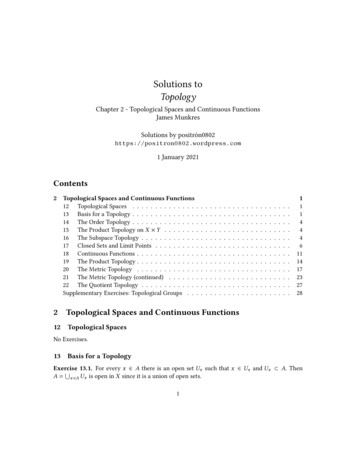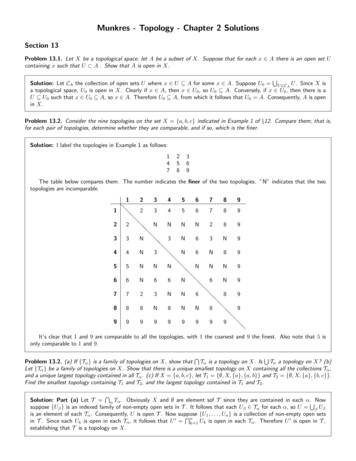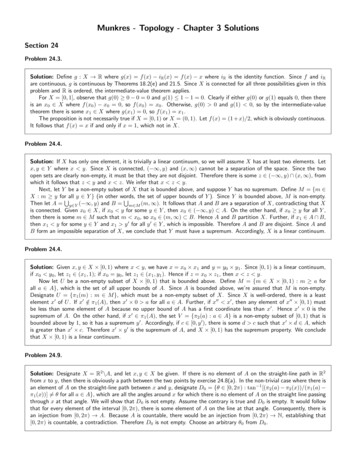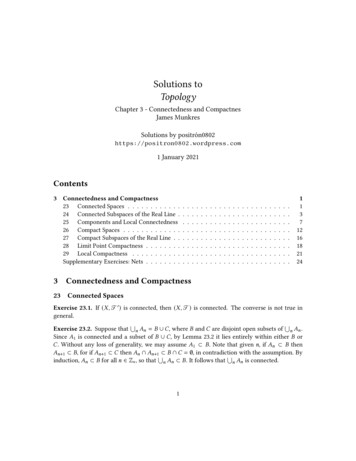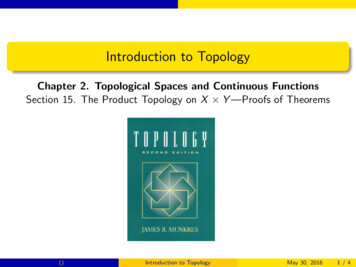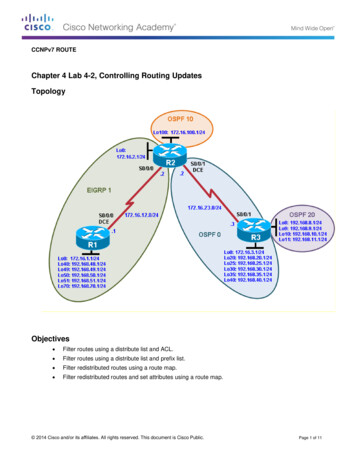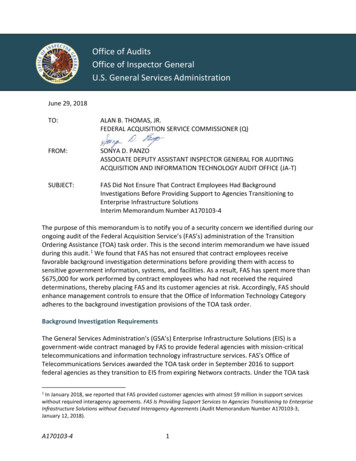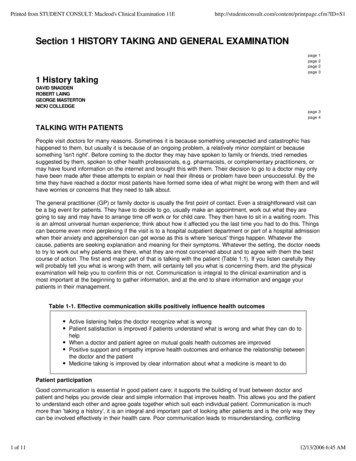
Transcription
Part 1General Topology
The goal of this part of the book is to teach the language of mathematics. More specifically, one of its most important components: thelanguage of set-theoretic topology, which treats the basic notions relatedto continuity. The term general topology means: this is the topology thatis needed and used by most mathematicians. A permanent usage in thecapacity of a common mathematical language has polished its system ofdefinitions and theorems. Nowadays, studying general topology reallymore resembles studying a language rather than mathematics: one needsto learn a lot of new words, while proofs of most theorems are extremelysimple. On the other hand, the theorems are numerous because theyplay the role of rules regulating usage of words.We have to warn the students for whom this is one of the first mathematical subjects. Do not hurry to fall in love with it, do not let animprinting happen. This field may seem to be charming, but it is notvery active. It hardly provides as much room for exciting new researchas many other fields.
CHAPTER 1Structures and Spaces§ 1 Digression on SetsWe begin with a digression, which we would like to consider unnecessary. Its subject is the first basic notions of the naive set theory. Thisis a part of the common mathematical language, too, but even moreprofound than general topology. We would not be able to say anythingabout topology without this part (look through the next section to seethat this is not an exaggeration). Naturally, it may be expected that thenaive set theory becomes familiar to a student when she or he studiesCalculus or Algebra, two subjects usually preceding topology. If this iswhat really happened to you, then, please, glance through this sectionand move to the next one.§ 1 1 Sets and ElementsIn any intellectual activity, one of the most profound actions is gathering objects into groups. The gathering is performed in mind and is notaccompanied with any action in the physical world. As soon as the grouphas been created and assigned a name, it can be a subject of thoughtsand arguments and, in particular, can be included into other groups.Mathematics has an elaborated system of notions, which organizes andregulates creating those groups and manipulating them. This system isthe naive set theory , which is a slightly misleading name because this israther a language than a theory.The first words in this language are set and element. By a set weunderstand an arbitrary collection of various objects. An object includedinto the collection is an element of the set. A set consists of its elements.It is also formed by them. To diversify wording, the word set is replacedby the word collection. Sometimes other words, such as class, family , andgroup, are used in the same sense, but this is not quite safe because eachof these words is associated in modern mathematics with a more specialmeaning, and hence should be used instead of the word set with caution.If x is an element of a set A, then we write x A and say that xbelongs to A and A contains x. The sign is a variant of the Greek letterepsilon, which is the first letter of the Latin word element. To makenotation more flexible, the formula x A is also allowed to be written3
§ 1. DIGRESSION ON SETS4in the form A x. So, the origin of notation is sort of ignored, buta more meaningful similarity to the inequality symbols and isemphasized. To state that x is not an element of A, we write x 6 A orA 6 x.§ 1 2 Equality of SetsA set is determined by its elements. It is nothing but a collection ofits elements. This manifests most sharply in the following principle: twosets are considered equal if and only if they have the same elements. In thissense, the word set has slightly disparaging meaning. When somethingis called a set, this shows, maybe unintentionally, a lack of interest towhatever organization of the elements of this set.For example, when we say that a line is a set of points, we assumethat two lines coincide if and only if they consist of the same points. Onthe other hand, we commit ourselves to consider all relations betweenpoints on a line (e.g., the distance between points, the order of points onthe line, etc.) separately from the notion of line.We may think of sets as boxes that can be built effortlessly aroundelements, just to distinguish them from the rest of the world. The cost ofthis lightness is that such a box is not more than the collection of elementsplaced inside. It is a little more than just a name: it is a declaration ofour wish to think about this collection of things as of entity and not togo into details about the nature of its members-elements. Elements, inturn, may also be sets, but as long as we consider them elements, theyplay the role of atoms, with their own original nature ignored.In modern Mathematics, the words set and element are very commonand appear in most texts. They are even overused. There are instanceswhen it is not appropriate to use them. For example, it is not good touse the word element as a replacement for other, more meaningful words.When you call something an element, then the set whose element is thisone should be clear. The word element makes sense only in combinationwith the word set, unless we deal with a nonmathematical term (likechemical element), or a rare old-fashioned exception from the commonmathematical terminology (sometimes the expression under the sign ofintegral is called an infinitesimal element; in old texts lines, planes, andother geometric images are also called elements). Euclid’s famous bookon Geometry is called Elements, too.§ 1 3 The Empty SetThus, an element may not be without a set. However, a set may haveno elements. Actually, there is a such set. This set is unique because a
§ 1. DIGRESSION ON SETS5set is completely determined by its elements. It is the empty set denotedby . 1§ 1 4 Basic Sets of NumbersBesides , there are few other sets so important that they have theirown unique names and notation. The set of all positive integers, i.e., 1,2, 3, 4, 5, . . . , etc., is denoted by N. The set of all integers, both positive,negative, and the zero, is denoted by Z. The set of all rational numbers(add to the integers those numbers which can be presented by fractions,like 23 and 7) is denoted by Q. The set of all real numbers (obtained by5 adjoining to rational numbers the numbers like 2 and π 3.14 . . . ) isdenoted by R. The set of complex numbers is denoted by C.§ 1 5 Describing a Set by Listing Its ElementsA set presented by a list a, b, . . . , x of its elements is denoted bythe symbol {a, b, . . . , x}. In other words, the list of objects enclosed incurly brackets denotes the set whose elements are listed. For example,{1, 2, 123} denotes the set consisting of the numbers 1, 2, and 123. Thesymbol {a, x, A} denotes the set consisting of three elements: a, x, andA, whatever objects these three letters are.1.1. What is { }? How many elements does it contain?1.2. Which of the following formulas are correct:1) { , { }}; 2) { } {{ }}; 3) {{ }}?A set consisting of a single element is a singleton. This is any setwhich can be presented as {a} for some a.1.3. Is {{ }} a singleton?Notice that sets {1, 2, 3} and {3, 2, 1, 2} are equal since they consistof the same elements. At first glance, lists with repetitions of elementsare never needed. There arises even a temptation to prohibit usage oflists with repetitions in such a notation. However, as it often happensto temptations to prohibit something, this would not be wise. In fact,quite often one cannot say a priori whether there are repetitions or not.For example, the elements in the list may depend on a parameter, andunder certain values of the parameter some entries of the list coincide,while for other values they don’t.1Other notation, like Λ, is also in use, but has become common one.
§ 1. DIGRESSION ON SETS61.4. How many elements do the following sets contain?1) {1, 2, 1};2) {1, 2, {1, 2}};3) {{2}};4) {{1}, 1};5) {1, };6) {{ }, };7) {{ }, { }}; 8) {x, 3x 1} for x R.§ 1 6 SubsetsIf A and B are sets and every element of A also belongs to B, thenwe say that A is a subset of B, or B includes A, and write A B orB A.The inclusion signs and resemble the inequality signs and for a good reason: in the world of sets, the inclusion signs are obviouscounterparts for the signs of inequalities.1.A. Let a set A consist of a elements, and a set B of b elements. Provethat if A B, then a b.§ 1 7 Properties of Inclusion1.B Reflexivity of Inclusion. Any set includes itself: A A holdstrue for any A.Thus, the inclusion signs are not completely true counterparts of theinequality signs and . They are closer to and . Notice that nonumber a satisfies the inequality a a.1.C The Empty Set Is Everywhere. A for any set A. In otherwords, the empty set is present in each set as a subset.Thus, each set A has two obvious subsets: the empty set and Aitself. A subset of A different from and A is a proper subset of A.This word is used when we do not want to consider the obvious subsets(which are improper ).1.D Transitivity of Inclusion. If A, B, and C are sets, A B, andB C, then A C.§ 1 8 To Prove Equality of Sets, Prove Two InclusionsWorking with sets, we need from time to time to prove that two sets,say A and B, which may have emerged in quite different ways, are equal.The most common way to do this is provided by the following theorem.1.E Criterion of Equality for Sets.A B if and only if A B and B A.
§ 1. DIGRESSION ON SETS7§ 1 9 Inclusion Versus Belonging1.F. x A if and only if {x} A.Despite this obvious relation between the notions of belonging andinclusion and similarity of the symbols and , the concepts arequite different. Indeed, A B means that A is an element in B (i.e.,one of the indivisible pieces comprising B), while A B means that Ais made of some of the elements of B.In particular, A A, while A 6 A for any reasonable A. Thus, belonging is not reflexive. One more difference: belonging is not transitive,while inclusion is.1.G Nonreflexivity of Belonging. Construct a set A such that A 6 A. Cf. 1.B.1.H Non-Transitivity of Belonging. Construct sets A, B, and Csuch that A B and B C, but A 6 C. Cf. 1.D.§ 1 10 Defining a Set by a ConditionAs we know (see § 1 5), a set can be described by presenting a listof its elements. This simplest way may be not available or, at least,be not the easiest one. For example, it is easy to say: “the set of allsolutions of the following equation” and write down the equation. Thisis a reasonable description of the set. At least, it is unambiguous. Havingaccepted it, we may start speaking on the set, studying its properties,and eventually may be lucky to solve the equation and obtain the list ofits solutions. However, the latter may be difficult and should not preventus from discussing the set.Thus, we see another way for description of a set: to formulate properties that distinguish the elements of the set among elements of somewider and already known set. Here is the corresponding notation: thesubset of a set A consisting of the elements x that satisfy a conditionP (x) is denoted by {x A P (x)}.1.5. Present the following sets by lists of their elements (i.e., in the form{a, b, . . . }):(a) {x N x 5}, (b) {x N x 0}, (c){x Z x 0}.§ 1 11 Intersection and UnionThe intersection of sets A and B is the set consisting of their commonelements, i.e., elements belonging both to A and B. It is denoted byA B and can be described by the formulaA B {x x A and x B}.
§ 1. DIGRESSION ON SETS8Two sets A and B are disjoint if their intersection is empty, i.e.,A B .The union of two sets A and B is the set consisting of all elementsthat belong to at least one of these sets. The union of A and B is denotedby A B. It can be described by the formulaA B {x x A or x B}.Here the conjunction or should be understood in the inclusive way: thestatement “x A or x B” means that x belongs to at least one of thesets A and B, but, maybe, to both of them.ABABABA BA BFigure 1. The sets A and B, their intersection A B,and their union A B.1.I Commutativity of and . For any two sets A and B, we haveA B B AA B B A.and1.6. Prove that for any set A we haveA A A,A A A,A A, and A .1.7. Prove that for any sets A and B we haveA B,iffA B A,iffA B B.1.J Associativity of and . For any sets A, B, and C, we have(A B) C A (B C)and(A B) C A (B C).Associativity allows us not to care about brackets and sometimes evenomit them. We define A B C (A B) C A (B C) andA B C (A B) C A (B C). However, intersection andunion of an arbitrarily large (in particular, infinite) collection of sets canbe defined directly, without reference to intersection or union of two sets.Indeed, let Γ be a collection of sets. The intersection of the sets in Γ isthe set formed Tby the elements that belong to every set in Γ. This setis denoted by A Γ A. Similarly, the union of the sets in Γ is the setformed by elementsthat belong to at least one of the sets in Γ. This setSis denoted by A Γ A.1.K. The notions of intersection and union of an arbitrary collectionof sets generalize the notions of intersection and union of two sets: forΓ {A, B}, we have\[C A B andC A B.C ΓC Γ
§ 1. DIGRESSION ON SETS91.8. Riddle. How do the notions of system of equations and intersection ofsets related to each other?1.L Two Distributivities. For any sets A, B, and C, we have(A B) C (A C) (B C),(1)(A B) C (A C) (B C).AB CAC(A B) C (A C)(2)B C (B C)Figure 2. The left-hand side (A B) C of equality (1)and the sets A C and B C, whose intersection is theright-hand side of the equality (1).In Figure 2, the first equality of Theorem 1.L is illustrated by a sortof comics. Such comics are
about topology without this part (look through the next section to see that this is not an exaggeration). Naturally, it may be expected that the naive set theory becomes familiar to a student when she or he studies Calculus or Algebra, two subjects usually preceding topology. If this is what really happened to you, then, please, glance through this section and move to the next one. §1 1 Sets .
